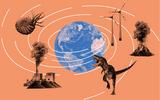MEK – K5 T1 A1 – “We need a vision we can get excited about”
Hannah Ritchie, environmental scientist
2025: Climate-warming gases continue to enter the atmosphere from the burning of fossil fuels and other sources. The transition away from coal, oil and gas is too slow.
At the same time, a lot is being done to limit global warming. The issue of climate change is being taken seriously in business and politics.
Many countries are pressing ahead with the transition to renewable energy sources, such as solar, wind and hydropower – in many places, these are now the cheapest option for the construction of new power plants.
Local, inexhaustible, low-cost – renewables offer numerous advantages, from energy self sufficiency to the preservation of a habitable environment.
2023: the global greenhouse gas emissions curve is still rising, in tandem with global temperatures.
To limit global warming to the level compatible with human civilisation (1.5–2°C), we should reduce greenhouse gas emissions to “net zero” by around 2050.
Net zero means not producing any more greenhouse gases and, at the same time, actively removing them from the atmosphere as much as possible and literally returning them to the ground – for example, in natural “sinks” such as restored wetlands, or in artificial stores. There are many possible ways of bending the curve.
Conventional agriculture and forestry are also major contributors to global warming. Intensive fertiliser use and overexploitation make farmland and forests significant sources of greenhouse gases. For example, after forest clearance or drainage, dried-out soils release the carbon dioxide bound in peat and humus.
As well as CO2, methane CH4 and nitrous oxide N2O are highly potent greenhouse gases. Huge amounts of nitrous oxide are emitted, for example, from liquid manure and other fertilisers applied to soil.
In addition, vast amounts of methane are produced by millions of cattle in industrial farming facilities. This greenhouse gas is more than twenty times as potent as carbon dioxide.
In 2025, coal-fired power plants still produce more than a third of the world’s electricity – and are responsible for around 40% of man-made carbon dioxide CO2 emissions.
These smoky monsters are essentially steam engines, operating on a principle more or less unchanged since the nineteenth century: coal is burned to heat water, with steam-driven turbines generating electricity.
In the age of artificial intelligence and other innovations, how long will we still need to use technology from the century before last? There are some encouraging signs: for example, though still a massive coal consumer, China is rapidly expanding its renewable energy capacity, and it reported a decline in its CO2 emissions for the first time in 2025. Will this trend continue?
This curve shows how global emissions of all greenhouse gases have developed over time. The most important greenhouse gas is carbon dioxide (CO2) produced by the burning of coal, oil and natural gas.
But global warming is also driven by gases such as methane (CH4) and nitrous oxide (N2O). To show their contribution, these emissions are converted into CO2-equivalent units.
Carbon dioxide CO2 is essential for life – without this gas, it would be extremely cold on Earth. But too much CO2 is detrimental to a world habitable for humans.
CO2 absorbs heat radiated from the Earth’s surface and releases it again – into space, but also back towards Earth. The more CO2, the hotter it gets: the planet becomes a greenhouse.
